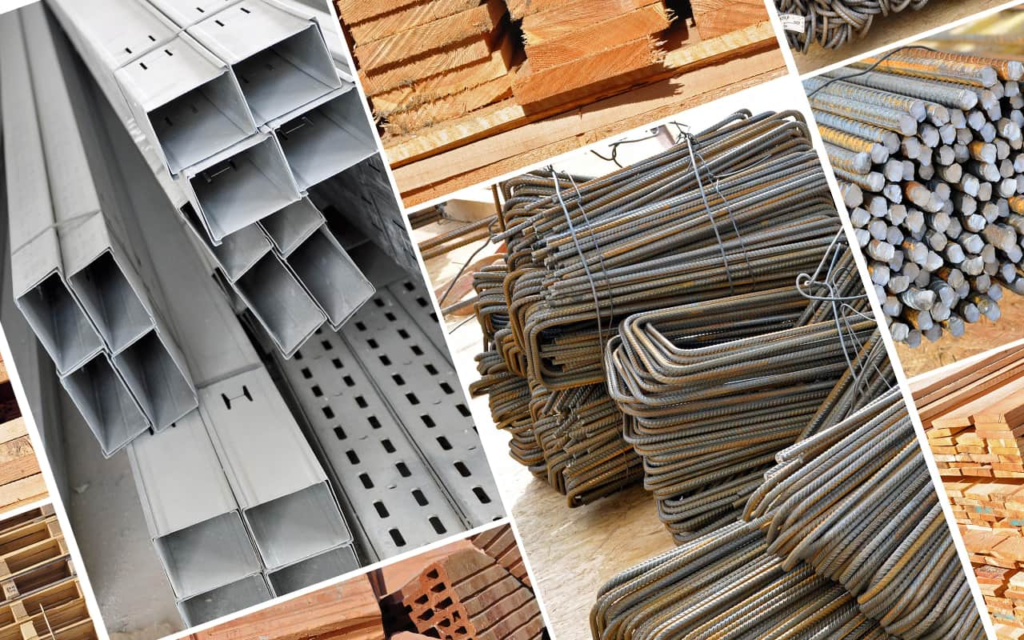
In the world of construction, the quality, durability, and sustainability of a structure depend heavily on the building materials used. From ancient stone structures to ultra-modern skyscrapers, the evolution of building materials reflects human progress, technological innovation, and environmental awareness. Today, the construction industry has access to a vast range of materials tailored for different purposes—each with its own strengths, weaknesses, and applications.
This article explores the various types of building materials, their properties, uses, advantages, and modern innovations. Whether you’re a builder, architect, homeowner, or student, understanding building materials is key to making informed decisions for any construction project.
What Are Building Materials?
Building materials are substances used in the construction of buildings, infrastructure, and other structures. These materials can be natural (like wood or stone) or synthetic (like steel or concrete), and are chosen based on their performance, availability, cost, and environmental impact.
Categories of Building Materials
Building materials can be broadly divided into the following categories:
1. Natural Building Materials
These are materials sourced from the earth with minimal processing. Examples include:
- Wood: Timber and bamboo
- Stone: Granite, limestone, sandstone
- Clay: Used in bricks, plaster
- Thatch: Dry vegetation used for roofing
- Mud and Straw: Traditional in eco-homes
2. Man-Made (Synthetic) Building Materials
These materials are manufactured through chemical or industrial processes:
- Concrete
- Steel
- Glass
- Bricks (fired clay)
- Plastic and composites
Essential Types of Building Materials
Let’s take a deeper look at the most commonly used materials in modern construction.
1. Concrete
Overview: A composite material made from cement, water, sand, and aggregates.
Applications:
- Foundations
- Floors
- Roads
- Bridges
- Walls
Advantages:
- Strong in compression
- Durable
- Fire-resistant
- Mouldable into any shape
Limitations:
- Weak in tension unless reinforced
- High carbon footprint
2. Steel
Overview: A high-strength alloy made of iron and carbon, often mixed with other elements for improved performance.
Applications:
- Structural frames
- Reinforcement in concrete
- Roofing
- Bridges
Advantages:
- Exceptional strength
- Ductile and elastic
- Recyclable
- Fast installation
Limitations:
- Susceptible to corrosion (unless treated)
- High cost compared to traditional materials
3. Wood (Timber)
Overview: One of the oldest and most versatile natural building materials.
Applications:
- Framing
- Flooring
- Roofing
- Furniture
Advantages:
- Renewable
- Easy to work with
- Good insulation
- Aesthetic appeal
Limitations:
- Vulnerable to moisture, pests, and fire
- Requires treatment for longevity
4. Brick and Block
Overview: Traditionally made from clay and fired in kilns; modern blocks may include concrete.
Applications:
- Walls
- Paving
- Chimneys
- Partitioning
Advantages:
- Durable
- Fireproof
- Thermally efficient
- Noise-insulating
Limitations:
- Labour-intensive
- Limited flexibility in design
5. Glass
Overview: Used for its aesthetic and transparency, available in toughened and insulated forms.
Applications:
- Windows
- Curtain walls
- Skylights
- Partitions
Advantages:
- Allows natural light
- Modern appearance
- Weather and corrosion-resistant
Limitations:
- Fragile
- Poor insulation unless double/triple-glazed
6. Plastic and Composites
Overview: Widely used in modern buildings, available in many forms like PVC, acrylic, and fibreglass.
Applications:
- Pipes
- Cladding
- Window frames
- Roofing
Advantages:
- Lightweight
- Corrosion-resistant
- Cost-effective
- Easy to mould
Limitations:
- Non-biodegradable
- Can weaken under UV exposure
Emerging Building Materials and Innovations
As technology advances and sustainability becomes a priority, new materials are reshaping construction.
1. Cross-Laminated Timber (CLT)
- Engineered wood panels
- Strong enough for multi-storey buildings
- Sustainable and carbon-efficient
2. Self-Healing Concrete
- Contains bacteria that activate when cracks form
- Extends lifespan and reduces maintenance
3. Aerogels and Vacuum Insulation Panels
- Ultra-light and efficient thermal insulation
- Ideal for passive homes
4. 3D Printed Materials
- Reduces material waste
- Enables custom design with speed
5. Recycled Building Materials
- Made from construction waste or recycled plastic/glass
- Supports circular economy and green building practices
Key Considerations When Choosing Building Materials
1. Structural Requirements
- Load-bearing capacity
- Tension and compression resistance
- Earthquake or wind load resistance
2. Durability
- Weather resistance (rain, wind, sun)
- Pest and decay resistance
- Fire safety
3. Thermal and Acoustic Properties
- Insulation efficiency
- Soundproofing qualities
4. Sustainability
- Energy usage during production
- Carbon footprint
- Reusability and recyclability
5. Aesthetics
- Visual appeal
- Colour and texture
- Cultural or architectural relevance
6. Cost and Availability
- Local material availability
- Transportation costs
- Long-term value vs. upfront cost
Sustainable Building Materials
Sustainability is becoming a cornerstone of modern construction. Here are some eco-friendly options:
- Bamboo: Fast-growing, strong, and renewable
- Reclaimed Wood: Repurposed from old structures
- Recycled Steel: Saves energy compared to virgin steel
- Cork: Renewable and sound-absorbing
- Hempcrete: Lightweight, breathable, and carbon-negative
Green building certifications like LEED and BREEAM encourage the use of these materials to reduce environmental impact.
The Role of Building Materials in Modern Architecture
Materials shape not only the structural integrity but also the form, function, and feel of a space. Modern architects experiment with:
- Glass and steel for transparency and elegance
- Concrete for brutalist or minimalist designs
- Timber for warmth and sustainability
Innovative use of materials allows for responsive architecture that adapts to climate, culture, and client needs.
Future Trends in Building Materials
The future of building materials lies in smart technologies, sustainability, and circular design. Key trends include:
- Biomimicry: Materials that mimic nature (e.g., lotus leaf-inspired coatings)
- Energy-generating materials: Solar tiles, kinetic flooring
- Transparent aluminium and graphene: Ultra-strong and versatile
- AI in material design: Custom materials for specific performance needs
As urban populations grow and climate change demands action, the role of innovative materials becomes even more vital.
Conclusion
Building materials are the backbone of the construction industry. From classic brick and stone to futuristic composites and 3D-printed elements, the choices are vast—and evolving. The right materials don’t just build structures; they build comfort, efficiency, sustainability, and style.
Choosing the appropriate building material involves balancing performance, cost, and environmental impact. With ongoing innovations and a rising demand for eco-conscious solutions, the world of building materials is more dynamic than ever.
